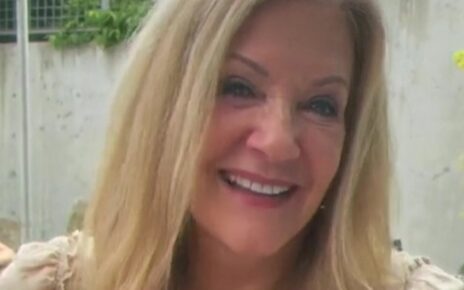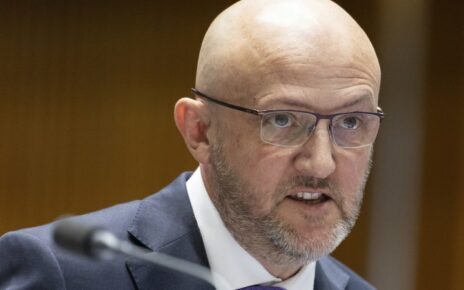The backchanneling began to pick up steam after the WGA strike passed the 60-day mark and actors joined writers on picket lines in July.
At that pivotal point, Chris Keyser and David Goodman, co-chairs of the Writers Guild of America negotiating committee, began having numerous conversations, by phone and in person, with key executives that influenced the course of the negotiations. After 146 days on strike, the WGA and AMPTP came to a tentative three-year agreement on the evening of Sept. 24.
Weeks before negotiations resumed, Keyser and Goodman met with Sony Pictures Entertainment chairman-CEO Tony Vinciquerra at the latter’s home. Netflix co-CEO Ted Sarandos did his own outreach, and so did other C-suiters. Before and after Labor Day, Keyser had telephone conversations with Warner Bros. Discovery CEO David Zaslav and Disney CEO Bob Iger — the two executives who had become the face of “corporate greed” for those on picket lines — that led to the Alliance of Motion Picture and Television Producers resuming formal negotiations on Sept. 20. In the days leading up to that meeting, long telephone conversations that Keyser held separately with Zaslav and Iger helped convince the management side that it was time to make a fresh move.
Instead of one Lew Wasserman-esque industry figure emerging from the din to serve as a peacemaker, the WGA and AMPTP were brought together in a hard-fought deal after weeks of private conversations among guild leaders and executives. The stalemate wasn’t broken by any one meeting or ultimatum, but the cumulative effect of many frank discussions of what it would take to end the impasse – which became even more fraught after SAG-AFTRA went on strike July 14.
WGA West president Meredith Stiehm and several WGA negotiating committee members with deep industry relationships also played a part. Throughout the strike, insiders said the WGA team was extremely disciplined in channeling discussions of significance through Keyser and Goodman.
In August, it was a conversation between Keyser and Zaslav that helped bring about the first in-person sit down between Keyser, Goodman and WGA West chief negotiator Ellen Stutzman with a quartet of top executives – Iger, Zaslav, Sarandos and NBCUniversal’s Donna Langley — at West L.A.’s Luxe Hotel on Aug. 22. That executive foursome ultimately led management in the final negotiations that produced the Sept. 24 accord.
“There have been conversations amongst us and the CEOs essentially all the way through this negotiation,” Keyser told Variety. “There were periods when it didn’t happen, but most specifically, from the point at which SAG went on strike, those ongoing conversations with the CEOs absolutely were central.”
By multiple accounts, the WGA group left the Aug. 22 meeting feeling as if they’d been given a stern lecture from the top brass about the terms of the package the AMPTP had presented to the guild on Aug. 18. The executives, however, left the meeting with a dawning realization about some shortcomings of that offer, which had further infuriated rank-and-file WGA members.
“They said it was full of loopholes, and they were right in some cases,” said a source with first-hand knowledge of the meeting.
The strength of the communication between Keyser and key execs was already moving the sides toward a resumption of negotiations after Labor Day – even before the WGA began to face stronger internal pressure from a strain of its most highly paid members. As if on cue, months into the strike, rumblings of showrunners and seasoned writers restless for answers on the guild’s strategy for closing a deal became loud enough to leak out from private WhatsApp and Facebook groups.
Goodman flatly rejects the suggestion that restless showrunners swayed WGA’s focus or negotiating strategy.
“The pressure was only the responsibility of making the deal the membership went on strike for,” Goodman told Variety. “We did talk to showrunners but the idea that we felt pressure from them to get in the room and make a deal — It’s just not true. Because the only way we could make the deal was when the companies were ready to make the deal.”
Keyser points to the deal itself as the strongest evidence that guild leaders were under no pressure to cave. “Take a look at the deal and see if this looks like a deal the showrunners pressured us to take,” he asked.
As the guild dealt with an outburst of internal politics, plans to resume negotiations were taking shape. On Sept. 14, Keyser placed a call to Zaslav. The Warner Bros. Discovery chief was eating dinner at a Manhattan restaurant, but stepped outside to take the call. The day before, Zaslav was at CNN headquarters at Hudson Yards when he ducked out of Christiane Amanpour’s 40th anniversary party to speak with Keyser by phone. After back-to-back conversations, Zaslav got the message loud and clear – it’s time to get back to the table.
On Sept. 18, the WGA negotiating committee emailed the membership to say it would imminently sit down with the AMPTP, having created a “confirmed schedule to bargain this week.” The word “bargain” was used for the first time in an official guild communication during this strike.
The awe-inspiring level of solidarity the guild received from its members had come at a great sacrifice – and was about to empower the WGA to achieve almost everything they sought, from a new model for streaming residuals to AI guardrails to minimum staffing guarantees.
On Sept. 20, industry observers were pleasantly surprised when the executive foursome showed up in-person at AMPTP headquarters in Sherman Oaks, as it was a strong signal that management was ready to wheel and deal. The sides spent eight hours going over nitty-gritty details about the use of AI, screenwriter fees, mind-numbing residual formulas and more. Among the executives, according to observers in the room, Iger and Langley repeatedly demonstrated their encyclopedic knowledge on all aspects of the production process. Sarandos was, naturally, the go-to source on streaming-centric issues (of which there were many). And Zaslav played the coach role to help keep the group focused on the urgency to get to the finish line.
This time around, the tone in the room was different. It was described as “civil,” according to four sources with knowledge of the meetings. By Thursday at lunch time, the producers and writers were finding common ground. On the matter of residuals, the studios and streamers agreed to pay out performance-based bonuses based on how many of their total active subscribers watch a film or series in its initial 90 days on the platform.
Keyser credits the executive foursome with doing their homework before the Sept. 20 sitdown.
“The CEOs had done a quite a bit of work before we got back into the room,” Keyser said. “When talks broke off, they had said no to any kind of compensation attached to [streaming] transparency. By the time we got back into the room, it was clear that they had heard us and made a proposal that became the basis for what we negotiated ultimately into the contract – the first time ever for a bonus for the shows that hit certain benchmarks in streaming. That’s an example of how they were responsive.”
The biggest threat to derailing the momentum emerged the following day. On Sept. 21, the executives were back in Sherman Oaks for another full day of talks, and by late afternoon, the management side was feeling optimistic that a deal was in sight. Shortly before 5 p.m. on Thursday, the executives sat for presentations on AI (one of the last matters to be resolved) before breaking for an early dinner. When they reconvened afterward, the WGA surprised the executives with a term sheet with deal points that hadn’t been discussed with the executives.
Iger and Zaslav, according to sources, didn’t hide their frustration. The executives who are accustomed to high-stakes dealmaking felt this was a reversal of the good faith that had been genuinely building between the sides. There were also renewed tensions around the WGA’s demands to honor the strikes of sibling unions, and to take steps to not return to work until the AMPTP completes a deal with SAG-AFTRA.
The executives suspected the evening surprise reflected the influence of David Young, the executive director of WGA West who went on medical leave in late February, weeks before the WGA and AMPTP first met for talks on March 20.
“David is playing great and powerful Oz, getting in people’s ears,” one source said Thursday night.
Football analogies were thrown around about how the sides had made it to the 10-yard line, and now these items amounted a flag on the field. Take this offer seriously, the executives warned. They walked out around 7:30 p.m. but they also let it be known that they were prepared to meet in person again the next day.
WGA West’s Stiehm has a different perspective on how the day ended, describing reports of a flare-up of tension as “a lot of nonsense.”
“Everyone was taking this very seriously; no one was playing games,” Stiehm told Variety. “Everyone wanted a deal and we’d worked really hard for three days on both sides to get there,” she says.
Indeed, by 10 p.m. on Sept. 21, the WGA reached out and a third day of talks was set for Sept. 22. The sundown start of the Yom Kippur holiday on Sept 24 became a soft target set as an unofficial deadline to reach a deal or, once again, retreat.
Writers and many others in the creative community had become laser-focused on the movement in the negotiating room. Encouraging signs were met with cautious optimism, as the WGA negotiating committee urged members to turn out strong to picket on Sept. 22. But word had spread of the Thursday night surprise. As one WGA member told Variety on Friday, “There is no tomorrow. If this thing implodes, where the fuck do we go from here?” Yet this person remained hopeful that this is the way that high-pressure negotiations go. “There’s always that last-minute breakdown, and then cooler heads prevail.”
By Sept. 23, the CEOs were no longer in the room, deferring to lawyers and negotiators on both sides to paper a tentative agreement. It was a frenzied day of rumors about progress and lack thereof, with worries coming from both sides that any deal might blow up because of the language around AI. On top of that, the WGA membership was enflamed that management used the terminology “best and final offer” for what they presented to negotiators that evening. Later that night, a joint statement from the guild and AMPTP confirming plans to meet again Sept. 24 did succeed in bringing down the temperature, a bit.
The sides connected by Zoom and conference calls in the late afternoon on Sunday, Sept. 24. Around 7:15 p.m. PT, the victory message WGA members longed to receive landed in their inboxes.
“What we have won in this contract – most particularly, everything we have gained since May 2nd – is due to the willingness of this membership to exercise its power, to demonstrate its solidarity, to walk side-by-side, to endure the pain and uncertainty of the past 146 days,” the negotiating committee wrote.
Despite the rocky road to the deal, Goodman and Keyser also gave credit to Iger, Langley, Sarandos and Zaslav for finally taking charge.
“There were moments that each one of them let it be known that they wanted this deal,” Goodman said. ”We were happy that all of them recognized the importance of it.”
Said Keyser: “The AMPTP requires consensus. Those four CEOs created a consensus on their side for the deal that you see.”
A tentative contract is now in place, one that guild members are expected to formally ratify during a seven-day voting period that ends Oct. 9. The pact has been forged after months during which the entertainment industry — still in a precarious place after COVID, and with the proliferation of streaming that’s up-ended previously profitable business models — has headed off a cliff.
News of the deal, a sweet ending to a bitter stalemate, came as the final rays of sun disappeared into the horizon over Beverly Hills on Sunday. The night before, Iger made an appearance in the glitzy neighborhood to dine with Paul McCartney at the neighborhood eatery La Dolce Vita. In a turn that a writer might deem as too on-the-nose, it so happened that one WGA member seeking shelter in pasta and wine amid the whirlwind negotiations spotted them, sending photographic evidence of the sighting to a WhatsApp text group that includes 500 showrunners. This writer heard a snippet of Iger and McCartney’s conversation, and shared it with the group.
The writer said Iger told McCartney over the dinner table that the town had “averted serious damage.”
On that point, management and labor agree.
“Our theory of the case was 100% right,” Goodman said. “Some of these companies could not ride out a strike. Despite the rumors being floated that this [strike] could go till next year, they needed a deal. We caused them pain. Once they realized they had to end it, they got serious and they made a great deal with us.”
(Pictured top row from left: Bob Iger, Ted Sarandos, Donna Langley. Bottom row from left: David Zaslav, David Goodman and Chris Keyser)
Read More About:
Source: Read Full Article


